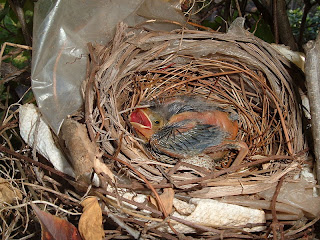But that's not the kind of cardinal I'm going to write about in my blog. Instead, I am going to write about the kind of cardinal that is a bright red bird. But I will just mention, before I stop talking about religious cardinals, that they like to wear bright red outfits, just like the birds. I thought the men were named after the birds, but Wikipedia says that the humans are called cardinals because they are "incardinated" into the Church (whatever that means). So I guess they decided they would wear red robes, and then later on, the red birds were named "cardinals."
Anyway, the I am only going to talk about Northern Cardinals, because that's the kind we have living in our back yard. There are several other types of cardinals, but the Northern Cardinal is called the common cardinal or redbird or Cardinalis cardinalis. It has a range that goes from southern Canada, through the eastern U.S., and down into Texas and Mexico.
Male cardinals are more colorful than females, which doesn't seem fair, but females have to sit on the nests and not be noticed, so it's best if they are more drab. The body length of a Northern Cardinal is about 8.3 inches (21 cm), and it has an average weight of 1.58 ounces (44.8 g). Both sexes have crests on their heads and a mask on the face. Their beaks are cone-shaped, coral-colored and very strong.
Northern Cardinals sing a lot, but they are not just singing for the fun of it. They sing to let other cardinals know which territory is theirs. The males will chase away any other males that come around. Both the males and females whistle song patterns that are repeated several times and then varied. If they are alarmed by something, like for example a predator, they will make a metallic "chip" sound. The closer the predator gets, the more, faster chipping the cardinals do. Also cardinal pairs might make the chip sound to locate each other, especially at dusk, when it's harder to see.
What Northern Cardinals most like to eat are weed seeds, grains, and fruits. They find their food while hopping around on the ground. Other stuff they like to eat includes beetles, cicadas, grasshoppers, snails, corn, oats, and sunflower seeds. Sometimes they also drink maple sap from holes made by sapsuckers. But mostly what they feed their babies is insects.
A pair of cardinals mates for life. While the male is courting the female, he will sometimes feed her by putting food into her beak. Then later, when she is sitting on the eggs, he will do this again. The nest is built by the female, but the male brings her all the nest material. She puts the nest in a hidden spot in a tree or shrubbery. It takes from 3 to 9 days to build the nest, and then the eggs are laid between 1 and 6 days after it is finished.
 |
| Newborn Northern Cardinal Photo by Parsons1, wikipedia.org |
The female lays 3 or 4 eggs, and then she sits on them for 12 to 13 days. Sometimes the male sits on the nest for a little while, but mostly she does all the sitting. After the chicks hatch out, they are ready to leave the nest only 10 to 11 days later. They may not know how to fly yet, but they have feathers, and they can leave the nest. These young birds are called fledglings, and the daddy cardinal feeds them until they can take care of themselves. Meanwhile, the mama bird builds another nest and lays more eggs. During one season, the cardinal pair might have 2 or 3 or even 4 broods of babies.
 |
| Week-Old Northern Cardinal Photo by Parsons1, wikipedia.org |
The predators that like to eat adult cardinals are falcons, hawks, shrikes, and owls. Eggs and chicks get eaten by snakes, blue jays, squirrels, chipmunks, and domestic cats.
Lots of people have Northern Cardinals living in their yards. Some people even put out sunflower seeds and safflower seeds to attract the cardinals. Because of this, the Northern Cardinal is not a threatened species. The estimated global range for this bird is 2,239,392.5 sq. mi., and the global population is maybe 100 million.
Many years ago, people liked to keep cardinals in cages as pets, but in 1918, the Migratory Bird Treaty Act made it illegal to sell cardinals as cage birds.
There are a bunch of sports teams that use the cardinal as their mascot. Also, it is the state bird of seven states: North Carolina, West Virginia, Ohio, Illinois, Indiana, Kentucky, and Virginia. This is more than any other bird. Delaware was almost going to make the cardinal its state bird, too, but then it decided to use the Delaware Blue Hen instead.
At our house, we have been hearing cardinals singing and chipping quite a bit lately, so in spite of all the snow, we can tell that spring is coming. We think the cardinals are probably claiming their territory and mating and maybe laying eggs already. Mom thought maybe there was a nest in the yew tree by our garage, but now she thinks what she saw was just a clump of dead leaves that fell off the sweetgum tree. Which is a shame, because we'd like to see some little baby cardinals hatching out of their eggs.

























0 comments:
Post a Comment